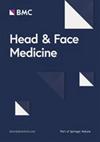Impact of manual therapy on body posture-3-D analysis with rasterstereography – pilotstudy
IF 2.4
2区 医学
Q2 DENTISTRY, ORAL SURGERY & MEDICINE
引用次数: 0
Abstract
The relationship between posture and temporomandibular disease (TMD) is unclear. The aim of our study was to determine the influence of manual therapy (MT) on posture in TMD patients compared with healthy subjects. After consideration of inclusion and exclusion criteria, 30 subjects were included. These were divided into two groups: group A comprised 15 healthy subjects and group B 15 patients with present proven TMD disease. Rasterstereographic images were taken at different times. Group A subjects were scanned twice within half a year and group B before initiation as well as after the first MT and after completion of the prescribed MT. The different posture variables were calculated using DIERS Formetric software. To illustrate the differences between the two groups, 10 different postural variables were examined. Significant differences between the two groups were observed in pelvic tilt, surface rotation, and kyphotic apex. Pelvic tilt: mean = 7.581, p-value = 0.029; surface rotation: mean = 3.098, p = 0.049; and mean kyphotic apex = 11.538 and 11.946, respectively, with p-values of 0.037 and 0.029, respectively. MT leads to a change in posture in TMD patients. This could influence the course of TMD treatment.徒手疗法对身体姿势的影响--利用光栅立体摄影进行三维分析--试点研究
姿势与颞下颌关节疾病(TMD)之间的关系尚不明确。我们的研究旨在确定与健康受试者相比,手法治疗(MT)对 TMD 患者姿势的影响。在考虑了纳入和排除标准后,我们纳入了 30 名受试者。这些受试者被分为两组:A 组包括 15 名健康受试者,B 组包括 15 名经证实患有 TMD 疾病的患者。在不同时间拍摄光栅立体图像。A 组受试者在半年内接受两次扫描,B 组受试者在开始 MT 之前、第一次 MT 之后以及完成规定的 MT 之后接受扫描。使用 DIERS Formetric 软件计算了不同的姿势变量。为了说明两组之间的差异,对 10 个不同的姿势变量进行了检查。两组在骨盆倾斜、表面旋转和畸形顶点方面存在显著差异。骨盆倾斜:平均值 = 7.581,P 值 = 0.029;表面旋转:平均值 = 3.098,P = 0.049;平均畸形顶分别为 11.538 和 11.946,P 值分别为 0.037 和 0.029。MT 导致 TMD 患者姿势的改变。这可能会影响 TMD 的治疗过程。
本文章由计算机程序翻译,如有差异,请以英文原文为准。
求助全文
约1分钟内获得全文
求助全文
来源期刊

Head & Face Medicine
DENTISTRY, ORAL SURGERY & MEDICINE-
CiteScore
4.70
自引率
3.30%
发文量
32
审稿时长
>12 weeks
期刊介绍:
Head & Face Medicine is a multidisciplinary open access journal that publishes basic and clinical research concerning all aspects of cranial, facial and oral conditions.
The journal covers all aspects of cranial, facial and oral diseases and their management. It has been designed as a multidisciplinary journal for clinicians and researchers involved in the diagnostic and therapeutic aspects of diseases which affect the human head and face. The journal is wide-ranging, covering the development, aetiology, epidemiology and therapy of head and face diseases to the basic science that underlies these diseases. Management of head and face diseases includes all aspects of surgical and non-surgical treatments including psychopharmacological therapies.
 求助内容:
求助内容: 应助结果提醒方式:
应助结果提醒方式:


